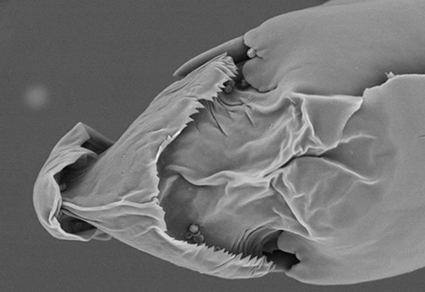Abstract
Male terminalia in insects with internal fertilization evolve more rapidly than other structures. The aedeagus is the most variable structure, making it a valuable diagnostic feature to distinguish species. The saltans group Sturtevant of Drosophila Fallén contains sibling species, that can be distinguished by their aedeagi. Here, we revised and illustrated the morphology of the male terminalia of the following species: Drosophila prosaltans Duda, 1927; D. saltans Sturtevant, 1916; D. lusaltans Magalhães, 1962; D. austrosaltans Spassky, 1957; D. septentriosaltans Magalhães, 1962; D. nigrosaltans Magalhães, 1962; D. pseudosaltans Magalhães, 1956; D. sturtevanti Duda, 1927; D. lehrmanae Madi-Ravazzi et al., 2021; D. dacunhai Mourão & Bicudo, 1967; D. milleri Magalhães, 1962; D. parasaltans Magalhães, 1956; D. emarginata Sturtevant, 1942; D. neoelliptica Pavan & Magalhães in Pavan, 1950; D. neosaltans Pavan & Magalhães in Pavan, 1950 and D. neocordata Magalhães, 1956. We found that phallic structures (e.g., the aedeagus) evolve more rapidly than periphallic structures (e.g., epandrium), being completely different among the subgroups and within them. This rapid evolution may be due to the action of sexual selection or to the potential role of those structures in speciation.
References
Arnqvist, G. (1997) The evolution of animal genitalia: distinguishing between hypotheses by single species studies. Biological Journal of the Linnean Society, 60 (3), 365–379. https://doi.org/10.1111/j.1095-8312.1997.tb01501.x
Bächli, G. (2021) TaxoDros: The database on Taxonomy of Drosophilidae; Database: TaxoDros. Available from: https //www.taxodros.uzh.ch/ (accessed 27 september 2021)
Buenaventura, E. & Pape, T. (2018) Phylogeny, evolution and male terminalia functionality of Sarcophaginae (Diptera: Sarcophagidae). Zoological Journal of the Linnean Society, 183, 808–906. https://doi.org/10.1093/zoolinnean/zlx070
Duda, O. (1927) Die sudamerikanischen Drosophiliden (Dipteren) unter Beruckssichtigung auch der anderen neotropischen sowie der nearktischen Arten. Archiv. Naturgesch, 91, 1–228.
Eberhard, W.G. (1985) Sexual selection and animal genitalia. Vol. 244. Harvard University Press, Cambridge, Massachusetts, 244 pp.
Eberhard, W.G. (1993) Evaluating models of sexual selection: Genitalia as a test case. The American Naturalist, 142 (3), 564–571. https://doi.org/10.1086/285556
Finet, C., Kassner, V.A., Carvalho, A.B., Chung, H., Day, J.P., Day, S., Delaney, E.K., De Ré, F.C., Dufour, H.D., Dupim, E., Izumitani, H.F., Gautério, T.B., Justen, J., Katoh, T., Kopp, A., Koshikawa, S., Longdon, B., Loreto, E.L., Nunes, M.D.S, Raja, K.K.B., Rebeiz, M., Ritchie, M.G., Saakyan, G., Sneddon, T., Teramoto, M., Tyukmaeva, V., Vanderlinde, T., Wey, E., Werner, T., Williams, T.M., Robe, L.J.,Toda, M.J. & Marlétaz, F. (2021) DrosoPhyla: Resources for Drosophilid Phylogeny and Systematics. Genome Biology and Evolution, 13 (8), evab179. https://doi.org/10.1093/gbe/evab179
Hosken, D.J. & Stockley, P. (2004) Sexual selection and genital evolution. Trends in Ecology & Evolution, 19 (2), 87–93. https://doi.org/10.1016/j.tree.2003.11.012
Hsu, T.C. (1949) The external genital apparatus of male Drosophilidae in relation to systematics. The University of Texas Publications, 4920, 80–142.
Kaneshiro, K.Y. (1969) A study of the relationships of Hawaiian Drosophila species based on external male genitalia. The University of Texas Publication, Austin, 6918, 55–70.
Madi-Ravazzi, L., Segala, L.F., Roman, B.E., Alevi, K.C.C., Prediger, C., Yassin, A., Hua-Van, A. & Miller, W.J. (2021) Integrative taxonomy and a new species description in the sturtevanti subgroup of the Drosophila saltans group (Diptera: Drosophilidae). Zootaxa, 4980 (2), 269–292. https://doi.org/10.11646/zootaxa.4980.2.3
Magalhães, L.E. (1956) Description of four new species of the saltans group of Drosophila (Diptera). Revista Brasileira de Biologia,16, 273–280.
Magalhaes, L.E. & Björnberg, A.J.S. (1957) Estudo da genitalia masculina de Drosophila do grupo saltans (Diptera). Revista Brasileira de Biologia, 17, 435–450.
Magalhães, L.E. (1962) Notes on the taxonomy, morphology and distribution of saltans group of Drosophila, with description of four new species. University of Texas Publications, 6205, 135–154.
Mourão, C.A. & Bicudo, H.E.M.C. (1967) Duas espécies novas de Drosophila do grupo saltans (Drosophilidae, diptera). Papéis avulsos de Zoologia, 12, 123–134.
Mayr, E. (1963) Animal species and evolution. Harvard University Press, Cambridge, Massachusetts, 797 pp.
Nater, H. (1953) Veigleichend morphologische Untersuchung des ausseren Geschlechts apparates innerhalb der Gattung Drosophila. Zoologische Jahrbucher, 81 (516), 438–485.
Pavan, C. & Magalhães, L.E. (1950) The saltans group of Drosophila. In Pavan, C (1950) Espécies Brasileiras de Drosophila. Boletim da Faculdade Filosofia, Ciências e Letras, Universidade de São Paulo, 111, 1–38.
Rice, G., David, J.R., Kamimura, Y., Masly, J.P., Mcgregor, A.P., Nagy, O., Noselli, S., Nunes, M.D.S., O’Grady, P., Sanchez-Herrero, E., Siegal, M.L., Toda, M.J., Rebeiz, M., Courtier-Orgogozo, V. & Yassin, A. (2019) A standardized nomenclature and atlas of the male terminalia of Drosophila melanogaster. Fly, 13 (1–4), 51–64. https://doi.org/10.1080/19336934.2019.1653733
Roman, B.E. (2018) Reconstrução filogenética do grupo saltans de Drosophila utilizando marcadores morfológicos e moleculares. Universidade Estadual Paulista “Júlio de Mesquita Filho”, São José do Rio Preto, 78 pp.
Shapiro, A.M. & Porter, A.H. (1989) The lock-and-key hypothesis: evolutionary and biosystematic interpretation of insect genitalia. Annual Review of Entomology, 34, 231–245. https://doi.org/10.1146/annurev.en.34.010189.001311
Soto, I.M., Carreira, V.P., Soto, E.M., Marquez, F., Lipko, P., & Hasson, E. (2013) Rapid divergent evolution of male genitalia among populations of Drosophila buzzatii. Evolutionary Biology, 40, 395–407. https://doi.org/10.1007/s11692-013-9223-x
Souza, T.A.J., Noll, F.B., Bicudo, H.E.M.C. & Madi-Ravazzi, L. (2014) Scanning Electron Microscopy of Male Terminalia and Its Application to Species Recognition and Phylogenetic Reconstruction in the Drosophila saltans Group. PLoS ONE, 9 (6), e97156. https://doi.org/10.1371/journal.pone.0097156
Spassky, B. (1957) Morphological differences between sibling species of Drosophila. University of Texas Publications, 5721, 48–61.
Sturtevant, A. H. (1916) Notes on North American Drosophilidae with descriptions of twenty-three new species. Annals of the Entomological Society of America, 9 (4), 323–343. https://doi.org/10.1093/aesa/9.4.323
Sturtevant, A.H. (1942) The classification of the genus Drosophila, with descriptions of nine new species. University of Texas Publications, 421, 5–51.
Throckmorton, L.H. (1975) The phylogeny, ecology, and geography of Drosophila. In: King, RC. (Ed.), Handbook of Genetics. Vol 3. Plenum Press, New York, New York, pp. 421–469.
Yassin, A. (2009) Phylogenetic Relationship Among Species Subgroups in the Drosophila saltans Group (Diptera: Drosophilidae): Can Morphology Solve a Molecular Conflict? Zoological Research, 30 (3), 225–232. https://doi.org/10.3724/SP.J.1141.2009.03225
Yassin, A. (2013) Phylogenetic classification of the Drosophilidae Rondani (Diptera): the role of morphology in the postgenomic era. Systematic Entomology, 38 (2), 349–364. https://doi.org/10.1111/j.1365-3113.2012.00665.x


